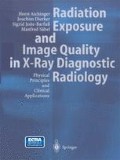Abstract
As an X-ray beam passes through material, there exist three alternatives for each photon:
-
1.
It can penetrate the material without interacting
-
2.
It can interact with material and be completely absorbed by depositing its energy
-
3.
It can interact and be scattered from its original direction, possibly depositing a part of its energy
Access this chapter
Tax calculation will be finalised at checkout
Purchases are for personal use only
Preview
Unable to display preview. Download preview PDF.
References
Attix FH (1986) Introduction to radiological physics and radiation dosimetry. Wiley, New York
Berger MJ and Hubbell JH (1987) XCOM: photon cross sections on a personal computer. NBSIR 87 – 3597. NBS, Washington, DC
Boone JM, Chavez AE (1996) Comparison of X-ray cross sections for diagnostic and therapeutic medical physics. Med Phys 23: 1997–2005
Cullen DE, Hubbell JH, Kissel L (1997) EPDL 1997: the evaluated photon data library. Lawrence Livermore National Laboratory Report UCRL-50400. vol. 6, rev. 5
DIN (Deutsches Institut für Normung) (1976) Aluminium — Halbzeug. DIN 1712 – 3. Beuth, Berlin
DIN (Deutsches Institut für Normung) (1983) Aluminiumlegierungen n Knetlegierungen. DIN 1725–1. Beuth, Berlin
Hammerstein GR, Miller DW, White DR, Masterson ME, Woodard HQ, Laughlin JS (1979) Absorbed radiation dose in mammography. Radiology 130: 485–491
Hermann KP, Geworski L, Muth M, Harder D (1985) Polyethylene-based water-equivalent phantom material for X-ray dosimetry at tube voltages from 10 to 100 kV. Phys Med Biol 30: 1195–2000
Hubbell JH (1999) Review of photon interaction cross section data in the medical and biological context. Phys Med Biol 44: 1–22
Hubbell JH, Seltzer SM (1995) Tables of X-ray mass attenuation coefficients and mass energy-absorption coefficients 1 keV to 20 MeV for elements Z = 1 to 92 and 48 additional substances of dosimetric interest. NISTIR 5632. Natl Inst Standards Technol, USA
ICRU (1989) Tissue substitutes in radiation dosimetry and measurement. Report 44. ICRU, Bethesda, MD
Klein J (1979) Zur filmmammographischen Nachweisbarkeitsgrenze von Mikroverkalkungen. Fortschr Röntgenstr 131: 205–210
Krieger H (1998) Grundlagen. Strahlenphysik, Dosimetrie und Strahlenschutz, vol. 1. Teubner, Stuttgart
NIST (2001) Database at http://physics.nist.gov/PhysRefData/contents.html
Schmidt B (2001) Dosisberechnungen für die Computertomographie. Thesis. University of Erlangen-Nürnberg, Germany
Author information
Authors and Affiliations
Rights and permissions
Copyright information
© 2004 Springer-Verlag Berlin Heidelberg
About this chapter
Cite this chapter
Aichinger, H., Dierker, J., Joite-Barfuß, S., Säbel, M. (2004). Interaction of Photons with Matter. In: Radiation Exposure and Image Quality in X-Ray Diagnostic Radiology. Springer, Berlin, Heidelberg. https://doi.org/10.1007/978-3-662-09654-3_3
Download citation
DOI: https://doi.org/10.1007/978-3-662-09654-3_3
Publisher Name: Springer, Berlin, Heidelberg
Print ISBN: 978-3-662-09656-7
Online ISBN: 978-3-662-09654-3
eBook Packages: Springer Book Archive

